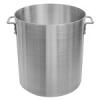Don't let yourself get caught up too much in the vernacular of "manufacturing" practices. FDA says anyone involved in food manufacturing or holding/packing falls under 21 CFR Part 117 Current Good Manufacturing Practices.
eCFR :: 21 CFR Part 117 -- Current Good Manufacturing Practice, Hazard Analysis, and Risk–Based Preventive Controls for Human Food
§ 117.1 Applicability and status.
(b) The operation of a facility that manufactures, processes, packs, or holds food for sale in the United States if the owner, operator, or agent in charge of such facility is required to comply with, and is not in compliance with, section 418 of the Federal Food, Drug, and Cosmetic Act or subpart C, D, E, F, or G of this part is a prohibited act under section 301(uu) of the Federal Food, Drug, and Cosmetic Act.
That said, you'll need to review your practices against the statutes as there are exemptions for facilities who only handle unexposed food.
§ 117.7 Applicability of subparts C, D, and G of this part to a facility solely engaged in the storage of unexposed packaged food.
(a) Applicability of subparts C and G. Subparts C and G of this part do not apply to a facility solely engaged in the storage of unexposed packaged food.
(b) Applicability of subpart D. A facility solely engaged in the storage of unexposed packaged food, including unexposed packaged food that requires time/temperature control to significantly minimize or prevent the growth of, or toxin production by, pathogens is subject to the modified requirements in § 117.206 for any unexposed packaged food that requires time/temperature control to significantly minimize or prevent the growth of, or toxin production by, pathogens.
If you guys are GFSI certified under storage and distribution or similar, following the codes applicable to you through such a program would usually keep your facility mostly compliant with FDA standards. And if you're not, downloading one of those codes could provide a framework for how to revise your program to determine which GMP portions are not applicable in your situation.














